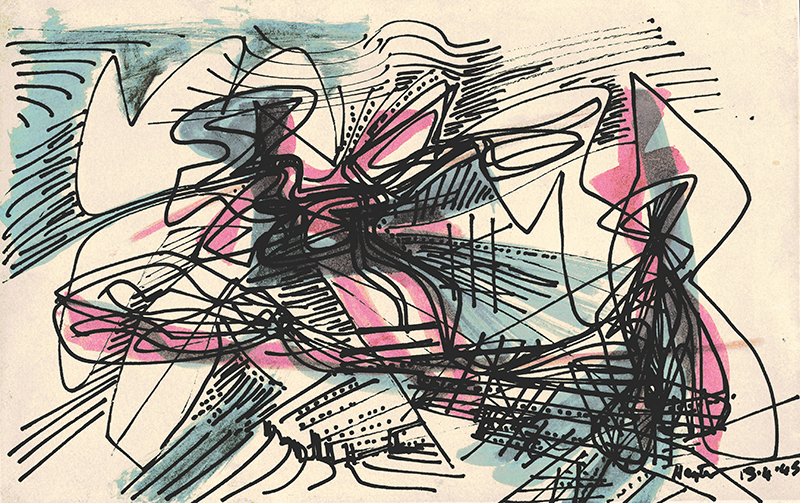
19th, 20th & 21st Century Fine Prints
707-546-7352 · fax 707-546-7924 · web: www.annexgalleries.com · email: artannex@aol.com
(Abstraction in magenta, aqua, black) by Stanley William Hayter

(Abstraction in magenta, aqua, black)
Stanley William Hayter
(Abstraction in magenta, aqua, black)
Stanley William Hayter
1901 - 1988 (biography)Scottish poet and artist Ruthven Todd, who had moved to Greenwich Village in 1947 when Hayter was running Atelier 17 in New York, observed his friend and mentor's painting process in "Hayter Paints a Picture." In it, Todd described how it always began with a felt-tip marker and two sheets of paper. Sketching impulsively on the paper - Hayter's signature "automatic line" method - a shape would begin to emerge, and at a point unknown to the observer but assured in Hayter's mind, the two images would be ready for rearranging in a particular way onto a third sheet for further changes.
This assembled image would then be transferred to a canvas spread upon the floor of his studio, and color would be applied in "successive thin washes of paint," as described by Martica Sawin on page 65 in Hayter: The Paintings, and a "brush drawing in Duco black enamel then traced linear arabesques built up one on top of another to form a progressive web." It's assumed this piece was one such study, though perhaps executed with more purpose to be its own composition, like a miniature example of his larger process.
Atelier 17 founder Stanley William Hayter was born in Hackney, England on December 27, 1901, to a family of artists. Though always interested in art, he began his adult life as a chemist and scientist. After working in the oil fields of Iran for three years, he went to Paris in 1926 to study at the Académie Julian. There he met the engraver Joseph Hecht and began to merge his early training in chemistry with a new found interest in printmaking.
The war years proved a pivotal time for Hayter in which he strove to create work that was less about the completion of an image than the process made visible. Here, even in such a small, brief composition, the artist's physical striving is apparent in the movement of the lines and the vibration that emerges from heavy black lines upon delicately layered hues.
Hayter spent most of his life in Paris where, in 1927, he founded an experimental workshop for the graphic arts, Atelier 17, that played a central role in the twentieth century revival of the print as an independent art form. The name Atelier 17 was adopted in 1933 when Hayter moved his establishment from its original home to 17 Rue Campagne Première. Through the late 1920s and into the 1930s he began a series of experiments using engraving, soft-ground etching, gaffrauge, open-bite, scorper and other innovative, textural techniques, all loosely based on the Surrealist/Jungian concepts of subconscious image and automatic line (Automatism). Artists from around the world gathered to work with him and ideas flowed freely. Hayter and most of the artists left Paris in late 1939 as war closed in on the city.
In 1940 Hayter moved to New York and re-founded Atelier 17 at the New School, moving to a studio on East 8 Street in 1945. The studio again became a melting pot for the artists who had arrived from Europe, American artists (many who had been part of the printmaking section of the WPA), and some young rebels (interested in breaking with the past and experimenting with technique and ideas). The emphasis in New York focused more on experimental color printing, including the use of viscosity printing and offset color using screenprint, stencil and woodcut. As in Paris, the salability of the image was near the bottom of the list of expectations.
Hayter returned to Paris in 1950 and re-established Atelier 17, attracting more international artists, many now coming from Asia. He continued to experiment with color printing, including the use of Flowmaster pens, incongruous and fluorescent colors and flowing, interwoven patterns. With an unrivaled knowledge of the technicalities of printmaking, Hayter authored two major books, New Ways of Gravure (1949) and About Prints (1962).
